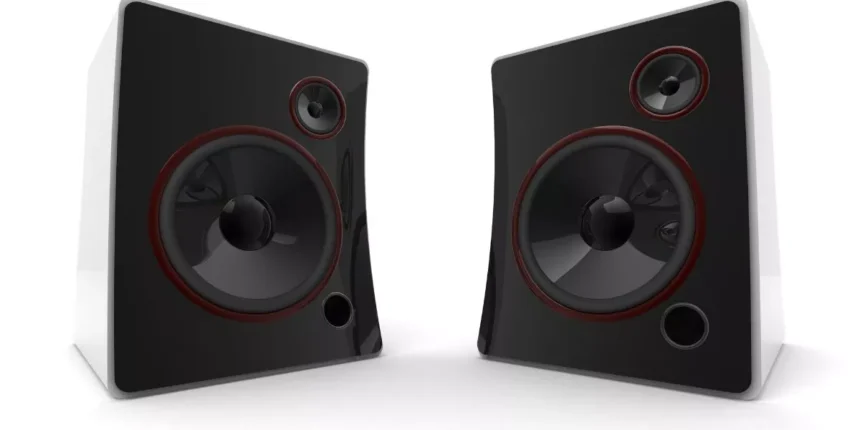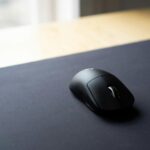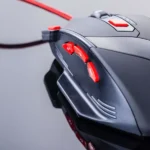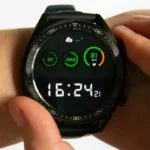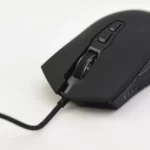Long battery life often defines a truly portable speaker, letting users move through a day without hunting for a charger. This list highlights five models that balance runtime, sound and durability for extended use. Each pick offers different strengths — from rugged waterproof builds to compact travel-friendly designs — so one can match priorities like bass, portability or extra features. More details follow to help choose the right fit.
- Honeywell Suono P400 Bluetooth Speaker with Deep Bass, RGB Lights, Type-C, SD/AUX, 10H Playtime
- HAMMER Drop 5W Bluetooth Wireless Speaker (Green)
- Tribit XSound Go Wireless Bluetooth Speaker (16W, IPX7, Black)
- Portronics SoundDrum P 20W Portable Bluetooth Speaker (Blue)
- Mivi Roam 2 Bluetooth Portable Waterproof Speaker
- Factors to Consider When Choosing 5 Wireless Speakers With Long Battery Life
- Battery Capacity (Mah)
- Real-World Playtime
- Charging Speed & Ports
- Power Efficiency Features
- Bluetooth Version & Range
- Size Versus Portability
- Usage Scenarios & Settings
- Conclusion
Honeywell Suono P400 Bluetooth Speaker with Deep Bass, RGB Lights, Type-C, SD/AUX, 10H Playtime
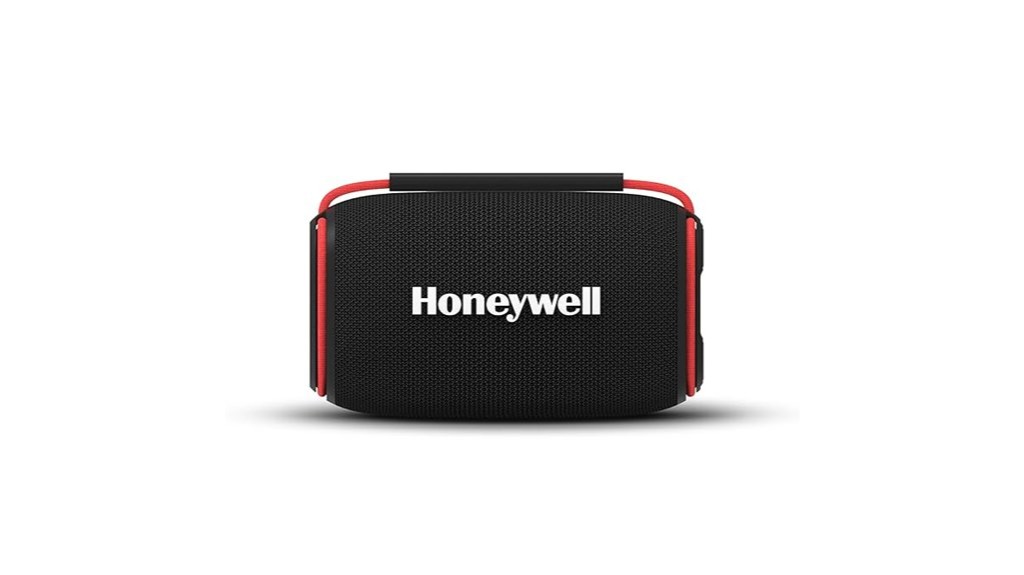
The Honeywell Suono P400 suits users who want a compact, party-ready Bluetooth speaker that balances loud, punchy sound with portable convenience—its 15 W output, twin passive bass radiators and 78 mm driver deliver pronounced low end while Bluetooth 5.3, TWS stereo pairing and SD/AUX/Type‑C playback options provide versatile connectivity for gatherings or travel. Weighing 650 g with a 2400 mAh battery, it claims up to 10 hours playback and supports Type‑C fast charging. IPX6 water resistance, RGB lights, built-in mic and included cables add value. User reviews praise build and volume; battery life and bass consistency draw mixed feedback.
Best For: users seeking a compact, party-ready Bluetooth speaker that combines punchy, portable sound with versatile playback options and eye-catching RGB lighting.
Pros:
- 15 W output with 78 mm driver and twin passive radiators delivers loud, punchy audio and enhanced low end.
- Multiple playback options (Bluetooth 5.3 with TWS, SD, AUX, Type‑C) plus built-in mic for calls and fast Type‑C charging.
- Portable, durable design with IPX6 water resistance, RGB lights, 10‑hour claimed battery life and included cables.
Cons:
- Actual battery life can be inconsistent (user reports from ~3 to 10 hours).
- Bass depth and overall clarity receive mixed feedback—may not satisfy bass purists.
- 15 W power and compact size limit performance in very large or outdoor party settings.
HAMMER Drop 5W Bluetooth Wireless Speaker (Green)

Offering up to 32 hours of playtime on a single 1,200 mAh charge, the HAMMER Drop 5W Bluetooth Wireless Speaker (Green) is an ideal pick for users who prioritize long battery life in a compact, portable package. Weighing 260 g with dimensions 10.5 x 8.2 x 5.1 cm, this 5W RMS, 52 mm driver speaker provides clear sound and notable bass for its price. Features include Bluetooth with auto-pairing, TWS stereo pairing, TF/USB playback, FM radio, Type-C charging and hands-free calling. Non‑waterproof and limited warranty; common feedback praises battery life and portability despite occasional FM reception issues.
Best For: users who want a compact, portable Bluetooth speaker with long battery life and good bass for casual home or outdoor listening.
Pros:
- Long battery life — up to 32 hours from a 1,200 mAh battery.
- Versatile playback — Bluetooth with auto-pairing, TWS stereo pairing, TF/USB playback, and FM radio.
- Lightweight and portable — compact dimensions (10.5 x 8.2 x 5.1 cm) and 260 g weight.
Cons:
- Not waterproof, limiting outdoor use in wet conditions.
- FM reception can be unreliable according to some users.
- Limited warranty and basic build material (plastic).
Tribit XSound Go Wireless Bluetooth Speaker (16W, IPX7, Black)
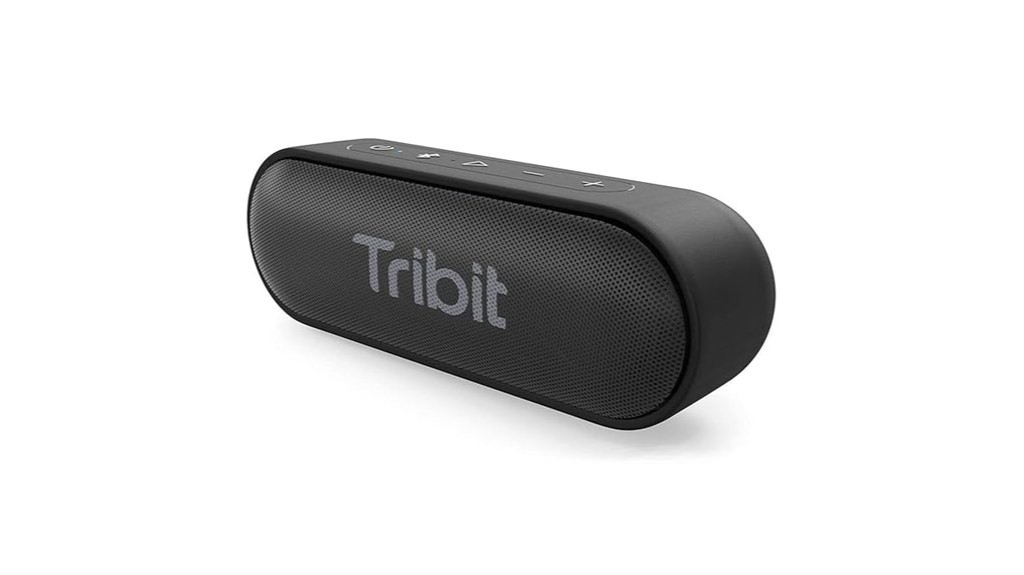
Ideal for commuters and small-group outdoor users who need all-day sound without frequent charging, the Tribit XSound Go pairs 24-hour battery life (manufacturer claim) with IPX7 waterproofing and a compact 16W dual-driver design. Weighing 367 g and measuring 17.2 x 5.7 x 6 cm, the BTS38 uses dual 8W drivers, passive radiators and DSP tuning for clear highs, crisp mids and enhanced bass without notable distortion. Bluetooth 5.3 extends range up to 150 ft, supports TRIBIT App and voice assistants, and includes a mic for calls. USB-C charging, lightweight build and strong user ratings underscore its value.
Best For: Ideal for commuters and small-group outdoor users who want portable, all-day playback with waterproofing and balanced sound.
Pros:
- Long claimed battery life (up to 24 hours) with compact, lightweight design for easy portability.
- IPX7 waterproofing and durable build suitable for pool, beach, or shower use.
- Clear highs and mids with enhanced bass from dual 8W drivers, passive radiators and DSP tuning; Bluetooth 5.3 and USB-C charging.
Cons:
- Real-world battery life can be much lower at high volumes (users report 8–18+ hours depending on use).
- Bass is balanced but not “boombox” level for users seeking very deep low-end.
- Occasional Bluetooth connectivity issues reported by some users; no AUX cable or power adapter included.
Portronics SoundDrum P 20W Portable Bluetooth Speaker (Blue)
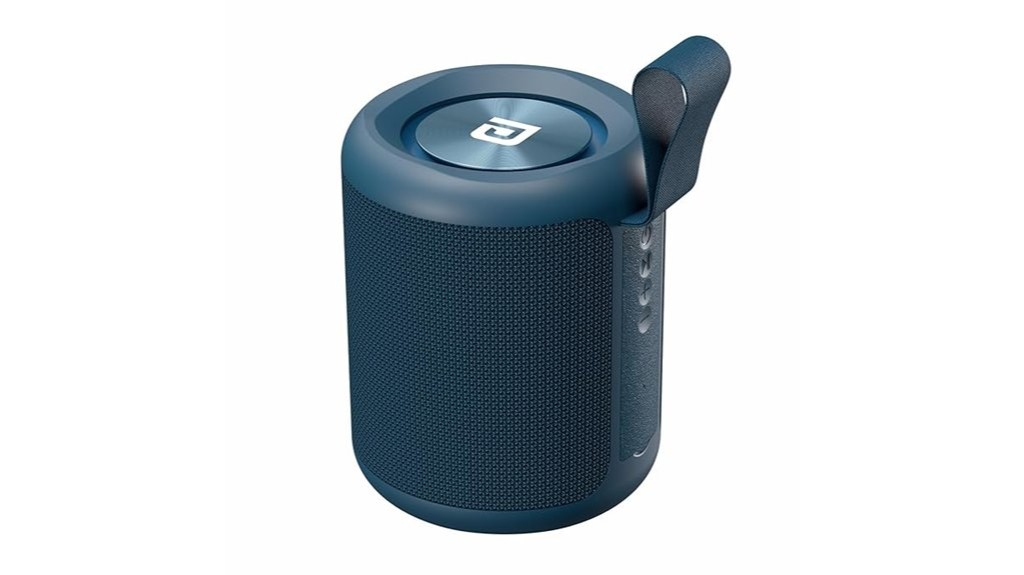
Boasting a 4000 mAh battery and punchy 20 W output, the Portronics SoundDrum P suits listeners who prioritize long runtimes and bass-forward portable sound for small gatherings or outdoor use. The compact blue speaker (13 x 10.5 x 10.5 cm, ~740 g) houses a 5-inch subwoofer, dual passive radiators and active amplification delivering strong lows, clear mids and high-volume clarity. Connectivity includes Bluetooth (reported v5.3), AUX, USB playback and Type-C charging; no TWS or app. Typical playback is 6–7 hours (reports up to 24 at low volume), charging varies. Controls and battery indication are basic; build and value are praised.
Best For: listeners who want a bass-forward, portable 20W speaker with long runtime and loud volume for small gatherings or outdoor use.
Pros:
- Punchy bass and clear mids with surprisingly high volume for its compact size.
- Good connectivity options (Bluetooth, AUX, USB) and Type-C charging; solid built build and value-for-money.
- Long battery life (4000 mAh) with typical multi-hour playback and lightweight, portable design.
Cons:
- Basic controls and coarse battery indication; touch/press controls can be unintuitive.
- No TWS pairing, app, FM radio, or official IP rating; rubber port cover can be stiff.
- Some users report Bluetooth dropouts with certain laptops and inconsistent volume behavior on Windows.
Mivi Roam 2 Bluetooth Portable Waterproof Speaker
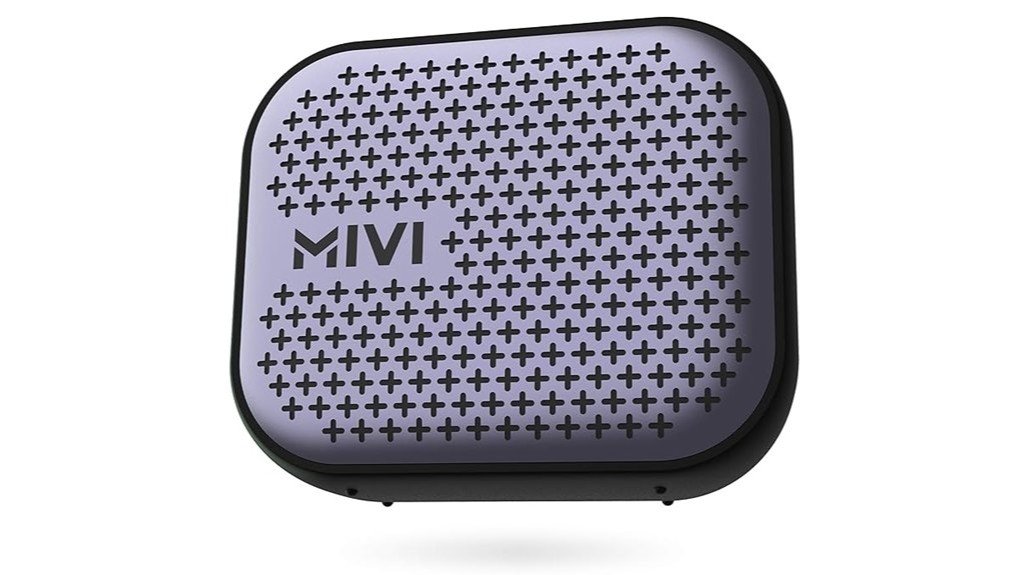
The Mivi Roam 2 is best suited for listeners who prioritize long battery life and punchy bass in a compact, water-resistant package. Mivi’s Roam 2 delivers 5W studio-quality sound with sharp trebles, detailed mids and heavy bass from a dynamic driver. Its IPX7 aluminium body measures 5 x 5 x 5 cm and weighs 204 g, offering tabletop use and portable durability. Bluetooth 5.0, stereo pairing, aux input, and a built-in microphone expand connectivity. A 2,000 mAh battery promises up to 24 hours at 70% volume with a four-hour charge. One-year warranty; popular with strong user ratings.
Best For: Listeners who want a compact, water-resistant speaker with long battery life and punchy bass for portable tabletop or outdoor use.
Pros:
- Compact, premium aluminium build with IPX7 waterproofing — durable and travel-friendly.
- Punchy bass and balanced 5W studio-quality sound with Bluetooth 5.0 and stereo pairing.
- Long claimed battery life (up to 24 hours at 70% volume) with included aux and mic for calls.
Cons:
- Small form factor may be prone to tipping or instability on some surfaces.
- Some contradictory specs (e.g., battery life / playtime numbers) and questionable listed dimensions in certain listings.
- 5W output may be insufficient for very large outdoor gatherings or high-volume needs.
Factors to Consider When Choosing 5 Wireless Speakers With Long Battery Life
When evaluating five wireless speakers for long battery life, attention should focus on battery capacity (mAh) and real-world playtime rather than headline figures alone. Charging speed, available ports, and power-efficiency features determine how quickly a speaker returns to use and how long it sustains playback under typical conditions. Bluetooth version and effective range complete the picture by affecting connection stability and energy consumption.
Battery Capacity (Mah)
Battery capacity, expressed in milliampere-hours (mAh), serves as the primary indicator of how much electrical energy a speaker can store and thus its potential continuous playtime under comparable power draw. Larger capacities (for example, 2,000–4,000 mAh or more) typically allow longer continuous playback, but runtime also depends on power output, volume, and amplifier/driver efficiency. mAh alone is insufficient: device voltage, battery chemistry, and power-management circuitry influence how mAh converts to usable hours. Higher-capacity batteries usually increase weight and size, so buyers should balance desired mAh against portability needs. When comparing models, consider mAh together with the manufacturer’s stated playtime at typical listening levels (around 50–70%), since identical mAh figures can yield different real-world runtimes.
Real-World Playtime
Although manufacturers’ “up to” runtime numbers provide a starting point, real-world playtime for portable speakers varies widely depending on listening volume, power draw, enabled features, and environmental conditions. Claims are measured at modest volumes (~50%); at louder levels (70–100%) expect a 30–70% reduction. Battery capacity (mAh) must be weighed against continuous watt output—higher mAh with lower watt draw yields longer use. Active features such as RGB lighting, DSP or boost modes, newer Bluetooth versions and hands-free calling increase consumption and shorten runtime versus idle music. Environmental factors—frequent reconnects, weak signals, extreme temperatures, wired inputs or EQ/BASS boosts—further reduce usable life. User- and third-party timed tests often reveal actual playtime ranging from near-rated at conservative volumes to 20–40% of claims at maximum loudness.
Charging Speed & Ports
Evaluating charging speed and ports is essential for minimizing downtime and matching a speaker to real‑world use patterns. Buyers should check charger type and port: USB‑C commonly enables higher currents and modern fast‑charge standards (e.g., PD), whereas micro‑USB or proprietary ports often limit input. Compare rated input current and voltage (mA/A and V); higher inputs such as 5V/2A or 9V/2A reduce recharge time versus 5V/1A. Look for advertised fast‑charge support and an estimated full‑charge time (for example, 2–4 hours versus 6–8 hours) to set expectations. Consider pass‑through or dual‑port capability to play while charging or to top up another device. Verify included cable and whether a high‑wattage adapter is required for claimed speeds.
Power Efficiency Features
When assessing power efficiency features, buyers should prioritize components and firmware that reduce draw without sacrificing sound: newer Bluetooth versions (5.0+) and low-energy profiles, Class D amplifiers with DSP-managed output, and codecs or adaptive bitrate handling all lower streaming consumption; combined with larger battery capacities (e.g., 2,000–4,000 mAh) and smart charging (USB‑C PD) these elements determine real-world runtime, while auto power‑off, standby modes, and firmware updates further trim idle drain and extend usable battery life. Buyers should compare battery capacity against nominal wattage, prefer DSP or Class D designs for higher efficiency, and confirm adaptive codecs to minimize streaming load. Serveable charging options and regular firmware support improve charging efficiency and long-term battery health.
Bluetooth Version & Range
After considering power‑saving hardware and firmware, attention turns to Bluetooth version and range, which directly influence streaming efficiency and reconnection behavior. Newer Bluetooth (5.0+) is more power‑efficient than legacy releases, lowering audio streaming energy draw and extending portable speaker runtime. Extended range in modern specs — roughly 30–45 m versus ~10 m for older versions in ideal conditions — also reduces reconnects and retransmissions that waste battery.
Support for Bluetooth Low Energy for discovery and control further conserves power by avoiding continuous classic‑A2DP signaling. Codec and profile choices matter: high‑bitrate codecs (aptX, LDAC) increase processing and radio activity slightly more than basic SBC. Finally, multipoint and TWS features add connection overhead; multiple simultaneous links typically raise consumption compared with a single link.
Size Versus Portability
Across sizes, portability is a practical trade‑off: larger enclosures typically contain bigger batteries and more drivers for longer runtimes and stronger bass, but they increase weight and carry bulk that reduce ease of transport. Larger speakers (2000–4000+ mAh) deliver extended play and deeper low end thanks to bigger cabinets, yet their added mass and volume harm pocketability. Compact models under ~400 g favor convenience, fitting bags or hands easily but often limit runtime to about 5–12 hours. Buyers should match intended carry methods: built‑in straps or lanyards can mitigate moderate size, while units over 700–800 g suit car‑to‑venue use rather than all‑day mobile carry. When true portability matters, prioritize dimensions and weight (≤300–400 g) over headline battery claims.
Usage Scenarios & Settings
Which scenarios will dictate the ideal battery and feature set for a wireless speaker? For all-day outdoor events (picnics, beach days) speakers with ≥20 hours playtime and IPX7+ water resistance prevent splashes or wet conditions from limiting runtime. Travelers and commuters benefit from compact models offering ≥10 hours and USB‑C fast charging or power‑bank pass‑through to reduce downtime. Home use across rooms requires 8–12 hours and a stable Bluetooth range of 10–15 m to avoid dropouts while moving about. Parties need ≥15 hours plus AUX/USB playback and TWS/stereo pairing to sustain loud, full sound without relying solely on Bluetooth. Professional or long-call scenarios call for ≥10 hours, dependable built‑in microphones, and low‑latency Bluetooth profiles for clear, uninterrupted voice communication.
Conclusion
When choosing a wireless speaker for extended playtime, battery endurance, charging convenience, and power efficiency take precedence alongside sound quality and portability. The Honeywell Suono P400, HAMMER Drop, Tribit XSound Go, Portronics SoundDrum P, and Mivi Roam 2 each balance runtime with specific strengths — deep bass, compact travelability, waterproofing, and punchy lows — making them suitable for varied listening scenarios where all-day performance matters. Prioritize features that match intended use.

